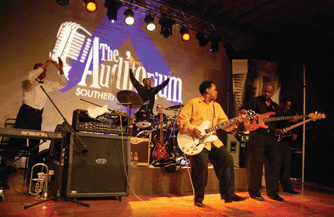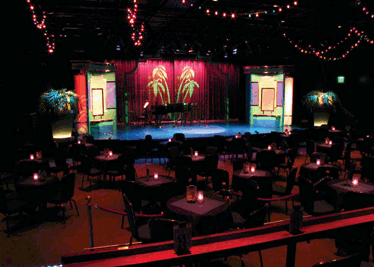Down But Not Out

Live Sound Helps Restore Deserted Downtowns Throughout The United States Neighborhoods that were once ghost towns in the ’70s, ’80s, and ’90s are experiencing a renaissance. From Jackson, MS to Sacramento, CA, families and creative class professionals
Mississippi’s empty Duling Elementary School was transformed into The Auditorium, a mixed-use complex for live entertainment, shopping, and dining that features a Peavey Versarray line array sound system. are moving from the suburbs into downtowns, the reverse migration of Baby Boomers.
This trend reflects how quickly the models that cities long relied on to define industry sectors and occupational demand have changed. The New Economy favors knowledge, communication, and innovation when it comes to assigning economic value and competitive vitality.
While the relationship between the “culture industries” and tourism has long been recognized, it is only recently that the full relationship with its broader economy has become clear. The key to keeping downtowns strong, as visionary author and urban planner Jane Jacobs discovered, isn’t keeping them empty and sterile. Rather, the heart and soul of city life are dense, diverse, and dynamic mixed-use neighborhoods.
No downtown can thrive with just chain stores, sans affordable housing or transportation. A healthy urban core needs reasons to live there or to return: museums, entertainment venues, schools, the FBI (food and beverage industry). When designed properly, nightclubs specifically contribute to the rejuvenation of desolate areas.
BIG CITY SOUND
A great example of nightclub’s restorative potential is in New York City, says industry consultant, systems designer, and software developer Sam Berkow. The Jazz Standard on 27th Street between Park Avenue and Lexington, “used to be in a dead area,” he said, “there was nobody around.” Now, the 160-seat venue is a draw for patrons because it prioritizes a phenomenal experience. It achieves the sound quality and user comfort where the original Jazz Standard fell short.”
What’s the recipe for success? A common mistake for jazz clubs is the way that they approach mixing. Mixing live jazz is fundamentally different than rock, Berkow says. “You must start with bass, then move to piano for that tight, swinging sound. In jazz, the bass drives it, where in rock the snare and kick drive the music.”
A daily selection of the top stories for AV integrators, resellers and consultants. Sign up below.
Another misconception is design. In a live jazz club, the room must be kept alive with stage sound being an important part of what people hear. The PA should provide balance and impact, not raw volume. “It’s a dual responsibility that’s not PA driven, but stage driven. Jazz clubs shouldn’t blow you out of your seat with sound—rather the quality of the playing should impress you.”
Meticulous design doesn’t only move the music along with rich and full acoustic bass, it also helps to create a welcoming environment that becomes part of the community itself. Nightclub venues shouldn’t be an obstacle, rather, a draw. “Good sight lines, good sound, the user experience and user comfort,” are the keys, Berkow suggests.

lease or you must offer top-notch food service and consistently good acts. Headliners come and go, the “Service and hospitality make the difference,” Berkow said.
RESTORATION AND PRESERVATION
Peavey’s Jim Beaugez pointed to the eclectic Fondren neighborhood of Jackson, MS, as another example of an inspiring downtown rejuvenation.
Over a two-year, intricate renovation process, the Fondren’s historic and empty Duling Elementary School was transformed into The Auditorium, a mixed-use complex for live entertainment, shopping, and dining.
In an ironic twist, the school’s previous gymnasium is now The Auditorium’s main venue. The 3,200- square-foot main entertainment room seats 170 people on average, but can fit 200. The Peavey-sponsored main stage features a Peavey Versarray line array sound system and space for top bill acts like legendary blues guitarist Eddie Cotton. “Architectural Acoustics Digitool MX processors make it easy for The Auditorium to convert from a regional-fare restaurant during the day and evening into a world-class entertainment venue at night,” Beaguez said. A smaller stage is located near the bar.
The restaurant is owned and managed by Jackson restaurateur Nathan Glenn, who specializes in southern fare. Patrons are treated to fresh Gulf Coast seafood and infamous Northern Mississippi barbecue.
Opened in March, there’s another bonus to The Auditorium—the artful renovation of the Duling School ensured that the Magnolia State won’t lose a beloved landmark. Preserving the Duling School’s style was crucial, Beaugez said, to the local community’s character. Many elements of The Auditorium are recycled from the original school structure; the bar surface was made with chalkboards from 1972.
The audio installation was performed by Kent Morris of Cornerstone Media Group, based in Atlanta, and features the very first line array from Peavey, including a ribbon driver. Why a true ribbon? “It’s not worth doing if you aren’t going to do it right,” Beaugez laughed.
Other system highlights include Versarray 218 subs, CS power amps, HPW misers, Dual DeltaFex multi-fx processor, and a CEL-2a compressor A thriving arts and culture community enhances a city’s competitiveness as well as help attract and retain businesses, so the exposure is great for Peavey. “It is great local and regional branding opportunities,” he said, as well as supporting a worthwhile investment. With sales representatives and projects in 136 countries, this Jackson install is yet another chance to show the world what Peavey can do.
OLD IS NEW AGAIN
Kasi Miller at Meyer Sound was enthusiastic about a variety of clubs renovations in long-shuttered downtown properties. She described a Sacramento installation in a 1950s Woolworth building that has been out of use for decades. Reborn as “The Cosmopolitan,” the building is now home to the Cosmopolitan Cabaret musical theater, a 200-seat venue with audio delivered by a Meyer Sound M1D line array system.

The long-shuttered 1950s Woolworth building in downtown Sacramento now houses the Cosmopolitan Cabaret musical theater, with audio delivered by a compact Meyer Sound M1D line array loudspeaker system. theater consultants, The Shalleck Collaborative, and installed by Hercules, CA-based Pro Media/UltraSound. The Meyer Sound system is centered around left and right arrays of six Meyer Sound M1D line array loudspeakers, each supported by a 600-HP sub.
Even coverage and focused pattern control was a challenge in this rectangular yet intimate space. Fortunately the M1D’s compact profile helped maintain lines of sight and coverage.
In addition to the Cosmopolitan Cabaret, operated by California Musical Theatre, The Cosmopolitan also houses a Social Nightclub and the Cosmo Café. San Francisco-based WRNS Studio was the project architect.
Miller also mentioned a recent Meyer Sound project in Las Vegas, a major renovation at the Mirage designed to attract new patrons as well as old clientele.
Margot Douaihy, Ph.D., is a lecturer at Franklin Pierce University.

